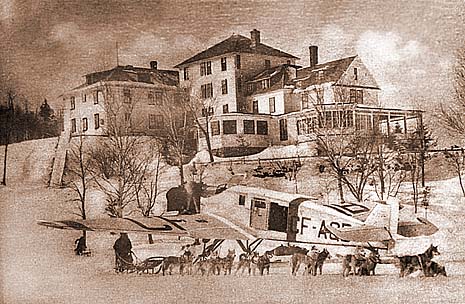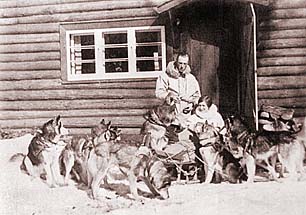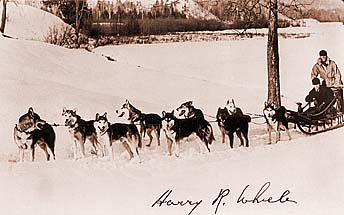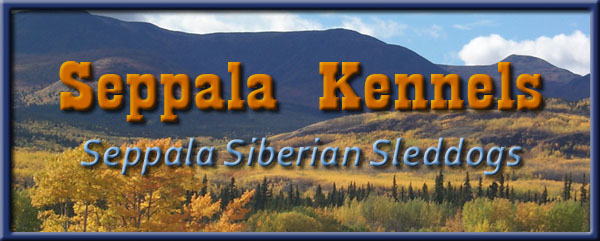
SEPPALA KENNELS of Harry Roberts Wheeler at Gray Rocks Inn, St. Jovite Station, Quebec, Canada, was crucial to the development of the Seppala Siberian Sleddog (as well as to that of the mainstream Siberian Husky). The longevity of the Wheeler kennel (twenty years) as well as its strategic ski resort location, together with its critical place in time, starting in 1930 and continuing until after the Second World War, gave it a preeminent influence. Wheeler made his presence felt in the dogsled races of Quebec and New England. In 1939 forty-seven of his dogs were registered with the Canadian Kennel Club as the "Siberian Huskie"; it is said that Wheeler resisted CKC registration, feeling that it would in the end be harmful to the strain as working dogs. How right he was, in a way; yet without that registration it seems improbable that the bloodline would survive today. Wheeler sold many dogs in New England to Cold River Kennels and various individuals; it seems likely that the registration of the Wheeler dogs came about through pressure from AKC, who would have required CKC registration certificates before they would register stock imported from Canada.
Very little is clear about the beginnings of the Wheeler kennel. Wheeler seems, like Eva Seeley, Elizabeth Ricker and others, to have been running a team of mongrels prior to his acquisition of Siberian dogs. He started with a pair, KINGEAK and PEARL, from the Poland Spring kennel and bred a litter from them. At some point, perhaps after Elizabeth Ricker divorced her first husband, Seppala and Ricker began to frequent Grey Rocks Inn and relocated the dogs there. Just how Wheeler acquired the core Poland Spring animals is not known, though speculative explanations have abounded. The brother and sister BONZO and TOSCA, the females MOLINKA and DUSHKA, and the three Siberia import males KREE VANKA, TSERKO and VOLCHOK, were all acquired in March 1931 from Seppala and Ricker, along with the right to use the name "Seppala Kennels."

An additional female, NANNA, was acquired from Alec Belford around two years later. As far as we know Wheeler never bought any other dogs than these ten. VOLCHOK does not appear in breeding records; BONZO the main leader sired no litter for Wheeler, nor was MOLINKA bred (at least, these two produced no registered progeny). Wheeler bred one litter from KINGEAK and PEARL, which he ran as a team, but SMOKEY OF SEPPALA was the only individual from that first litter to contribute to further registered breeding. Wheeler's usual pattern was to breed KREE VANKA to TOSCA (repeatedly -- he bred neither one to any other mate); the resulting females he bred to TSERKO, who also mated DUSHKA once, producing brood bitch SIGRID OF SEPPALA and the famous Turner leader SAPSUK OF SEPPALA. SMOKEY OF SEPPALA was bred repeatedly to SIGRID OF SEPPALA and to NANNA. Thus a strong pedigree pattern was set up in the early Wheeler breeding. We do not know the rationale for his strangely structured breeding programme. In twenty years, thirty-eight litters were bred in the Wheeler kennel.
THE SALE OF DOGS from the Wheeler kennel to New England buyers was critical to development of the Siberian Husky breed in the USA. The sale of BURKA OF SEPPALA and VANKA OF SEPPALA to Fred Lovejoy, of WOLFE OF SEPPALA to Robert Hoover, and of SAPSUK, UGRUK, JUNEAU, SURGUT, TONGASS, VANKA II, SKY (all OF SEPPALA) and others to Marie Turner, plus other dogs to Shearer and Belford, decisively influenced most early bloodlines, among them FOXSTAND, CHINOOK and MONADNOCK. (The pedigree of CH. MONADNOCK'S PANDO, for example, shows about 50% Wheeler ancestry when taken back 7 generations.) Despite the attention paid to the Eva B. Seeley Chinook Kennels in popular breed histories, the Wheeler kennel was at least as influential and probably considerably more so.

The Wheeler team was a significant force on race trails in the 1940s. BORIS OF SEPPALA and BURKA OF SEPPALA II succeeded BONZO as main leaders. The dogs at Gray Rocks Inn, however, were part of the amenities of the ski resort and were often used for dogsled excursions with passengers; thus they were multipurpose sleddogs, not racing dogs as such. Many of the Wheeler dogs were long-coated and over the years a number of these were sold to William L. Shearer III, Boston, MA, who preferred long-coated Siberians. When Wheeler finally sold his remaining stock in 1950 to J. D. McFaul (along with the kennel name), McFaul immediately resold a number of dogs. He explained to me in an interview that he had sold the long-coated individuals to Shearer! The twenty year history of the Wheeler kennel had an overwhelming influence on most of the major Siberian breeders of the 1930s and 1940s. It established a sound genetic base for both the Siberian Husky and ultimately, the Seppala Siberian Sleddog.
THE INFLUENCE OF WHEELER, Shearer, the Belfords and McFaul is consistently slighted and minimised in Siberian Husky breed books. That fact only reflects the overwhelming orientation of that breed towards dog shows; it is necessary for its authors to emphasise the early show kennels even though those kennels (Chinook, Monadnock, Kabkol and others) were of minor importance compared to the working sleddog kennels of Seppala, Ricker and their successors. The present-day Seppala Siberian Sleddog breed -- not the Siberian Husky -- is the legitimate inheritor of the Leonhard Seppala legacy through the strong trunk of the Wheeler, Shearer, Belford, McFaul, Bryar and McDougall bloodlines. The Wheeler kennel stands at the point at which the Siberian dogs' family tree diverged into two separate trunks; its genes are common to both the Siberian Husky show dog and the Seppala Siberian Sleddog. After the Wheeler kennel came the "unique Seppala" sleddog history, and the history of the modern Siberian show dog. Yet Wheeler had no interest in dog shows. I believe I know which dogs he would consider to be the legitimate descendants of his stock.
